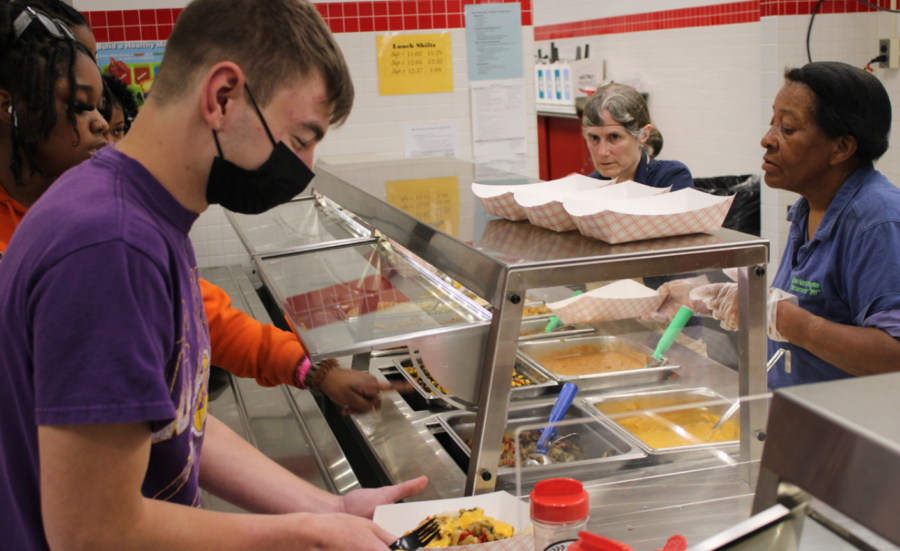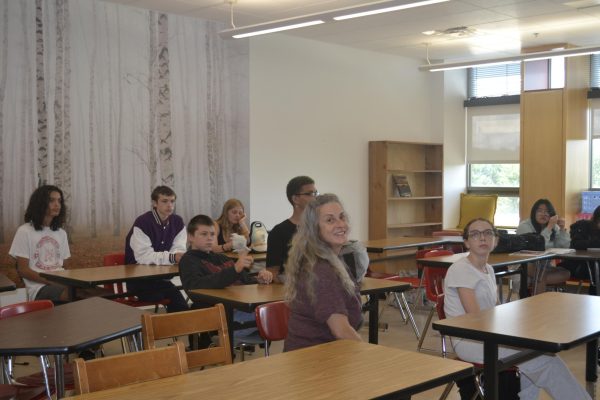FHS Cafeteria Diversifies Meal Options for Students
Students purchase food from one of FHS’s many lines.
Eating lunch at FHS has suddenly become much more enjoyable, with a wide variety of options now available to suit even the most picky eaters. In recent years, FHS has opened up two new food lines, with more proposed options that might be available soon. Spearheading these changes has been the responsibility of the FCPS1 Nutrition Department, led by SueAnn Fox.
Navigating through the pandemic was challenging for school cafeterias, but may have resulted in better food for students. “During the pandemic, with a lack of labor in some places, they shut down factories, and they had to produce what made the most money for them, and obviously school lunches are very affordable… so they stopped making a lot of our products,” said Fox. Therefore, FCPS1 started investing in equipment to produce more food locally and to reduce reliance on preprocessed food. A major component of this was the brand new addition of a processing kitchen at Southeastern High School. “What we’re going to process is local fruits and vegetables in a format that makes [them] usable for schools. So, if a farmer wanted to sell me a truckload of sweet potatoes, that could be very difficult. So what we’re doing is we put in equipment, so we can take a sweet potato, cube it, and then we can make you roasted sweet potatoes, or we can make fresh french fries,” said Fox.
FHS students can now enjoy even more options than ever before, including the addition of a made-to-order sub line and an international line. Students have also praised the newly-added international line, with Asian, Italian and Mexican options. “I think it’s a great push for more diverse food,” said junior Leguejou Awunganyi. “The [international line] is the best line,” sophomore David Ponn added.
In the future, there may be even more options available at the international line. “Next year we hope to add two more concepts: we’re kind of toying with Indian and Mediterranean, and we’re also talking about down-home favorites,” said Fox. Chicken sandwiches may also receive a major boost in quality, as the county expects to switch to a chicken muscle, found on most high-quality sandwiches.
All of these changes have been made with the health of FHS students in mind. Entrees are generally nutrition-packed and a healthier version of whatever students are typically used to. “For instance, with pizza, it’s a whole grain crust with fortified sauce and low fat cheese, so it’s a healthier version of what kids like,” said Fox. The county also must comply with strict federal and state guidelines when serving lunch food. For example, a cafeteria meal cannot exceed 10 percent of one’s total daily recommended saturated fat intake.
FHS students are also beginning to take notice of the changes. Awunganyi said she was satisfied with the food, saying, “[It’s] pleasing. I think with the amount of funding we have, it’s the best they can do.”
Despite pandemic challenges and food insecurity, the nutrition team at FHS continues to move towards better, healthier food choices. “People go too hard on it, it’s actually pretty good,” said Ponn. Fox indicated that the effort to improve the food will always continue, saying, “I don’t think there’s an end in sight. Every day we’re looking at new products, new ways to bring fresh things to students.”
Thanks for reading The Falconer. We're happy to provide you with award-winning student journalism since 1963, free from bias, conflicts of interest, and paywalls. We're able to continue with the generous support of our local community. If you're able, please consider making a donation. Any amount is incredibly helpful and allows us to pursue new and exciting opportunities.

Hey! My name is David Achter, and I'm an Editor-in-Chief. I'm a senior, and this is the third year I've worked with the newspaper. I am a volunteer EMT...






